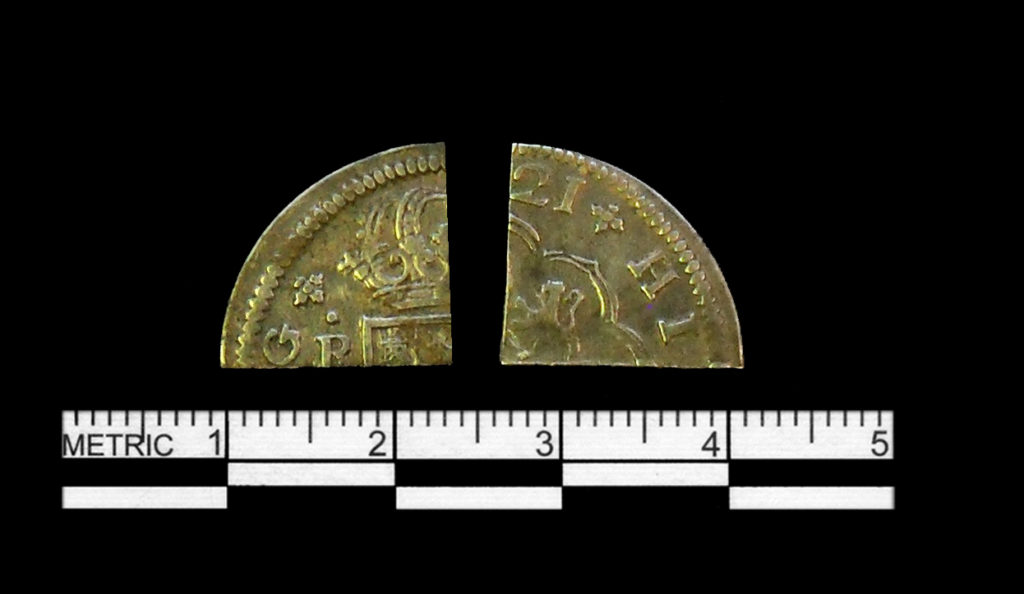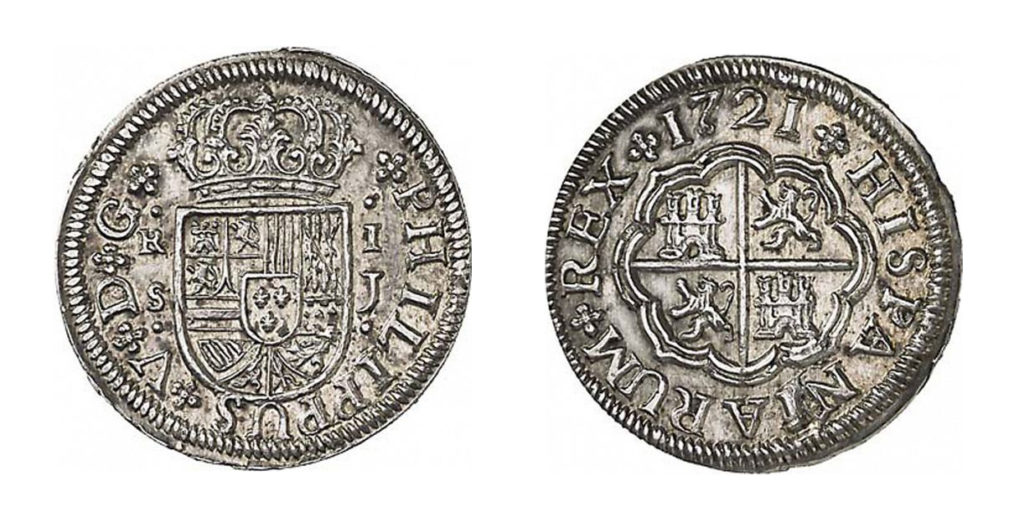Featured Fragment – Clipped Coins in Colonial America
By Kerry S. González and Mara Katkins
For this month’s blog post, we have decided to join forces with Mara Katkins with George Washington’s Ferry Farm to showcase some of the clipped coins found in the Fredericksburg region.
In the summer of 2015 Dovetail Cultural Resource Group conducted Phase III excavations for the Virginia Department of Transportation’s Fall Hill Avenue Expansion Project in Fredericksburg, Virginia. During the excavation of site 44SP0642 a silver clipped Spanish Real (pronounced re-AL) was recovered from a borrow pit dating to 1775–1795 (Photo 1 and 2). This date range was obtained from an analysis of diagnostic artifacts, primarily ceramics, collected from the different filling episodes within the pit. The partial Real was marked with a date of 1721, years prior to the interpreted filling of the borrow pit—an indication of the value of a precious metal like silver.
A number of coins cut into segments have also been excavated at Ferry Farm, the boyhood home of George Washington (site 44ST0174) as well as from Historic Kenmore, the home of Betty Washington, sister of George Washington and wife of Fielding Lewis (site 44SP0073). The half coin pictured below (Photo 3, center) was recovered from the yard area of the first European dwelling on the Ferry Farm property, dubbed the Maurice Clark house. Clark was an indentured servant whose term was up in 1710. It appears that he had just enough time to build a 20 x 30-foot post-in-ground building on the Ferry Farm property and enjoy about six months of freedom before he died. The land was eventually purchased by the Strother’s, who built a dwelling there in 1728. The Washington family bought the parcel and moved into the house in 1738. They remained there until 1772, when George’s mother, Mary, was the last one to leave. The quarter and eighth coins pictured in Photo 3 (left and right) were recovered from the backyard area of the Washington home. A very similar coin, cut into a quarter, was excavated at Kenmore, built in the mid-1770’s.

Photo 2: Clipped Real Recovered During Dovetail’s Excavation at Site 44SP0642. On left: obverse of clipped coin. On right: reverse of clipped coin.
The presence of Spanish coins on colonial sites is due to the pervasively contentious relationship between the colonists and the British government. Parliament believed that the colonists should be providing Britain with precious metals instead of taking them across the ocean (Jordan 1997). In response to the dearth of available British currency, the colonists began to use foreign coins when bartering was not an option. While bartering of tobacco and wampum were generally acceptable for most exchanges, certain British exporters would only deal in silver, thus the need for other forms of currency (Jordan 1997).
Most clipped coins found on archaeological sites are quartered or halved, however even smaller divisions of coins were not uncommon (see Photo 3). Clipping silver and gold coins was a common way of making change in the colonial period as coins were made to be worth their weight in precious metals, in this case silver. It was also an easy way to make small purchases. Not only were coins clipped into sections, they were also ‘trimmed’ by removing the edges of the coin, essentially retaining some of the precious metal for future purchases. Recovering artifacts such as these clipped coins offers insight into the sometimes tumultuous economic setting of colonial and early American life in the states.

Photo 3: Clipped Coins Recovered From George Washington’s Ferry Farm and Historic Kenmore. The center coin came from the Clark House, while the left and right coins were found in the Washington yard.
Any distributions of blog content, including text or images, should reference this blog in full citation. Data contained herein is the property of Dovetail Cultural Resource Group and its affiliates.

